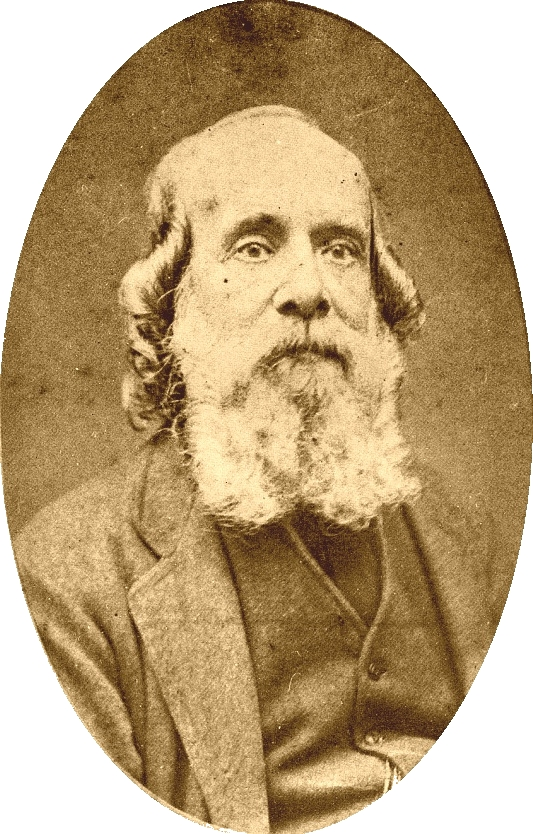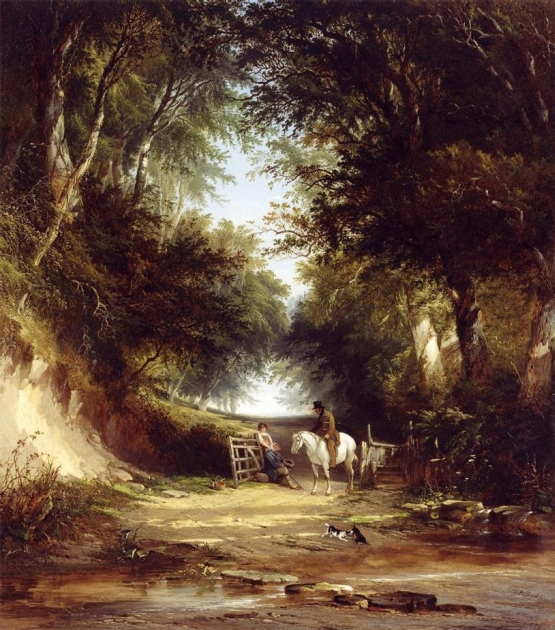The Children (Part 1)
Edward Charles Williams and Henry John Boddington
Edward Charles Williams
A year after Edward Williams and Ann Hilderbrandt married, she gave birth on July 10th 1807 to their first child, a boy, who was christened Edward Charles at St Mary’s Church in the St. Marylebone parish of Westminster. When he was still a child Edward Charles was taught to paint by his father and in years to come their styles were so similar it was difficult to detect the artist of some of their works, especially their woodland scenes.

As neither father nor son consistently signed their works, it can be very difficult to ascertain which one painted a given canvas. To complicate things even further Edward Charles Williams signed some of his paintings E Williams, which led to confusion with paintings by his father, and at other times he would sign his work C Williams. Like his father’s love of the work by the Dutch Golden Age landscape painters, his son was greatly influenced by those Dutch masters.

Edward Charles spent most of his life living around London and often his paintings depicted the countryside of the counties surrounding the capital such as Kent, Surrey, Sussex and Essex. On December 11th 1839, when Edward was thirty-two, he married Mary Ann Challenger at the St Marylebone Church in Westminster.

In the early 1840’s he was living at 2, London Street which was close to the homes of two well-known Pre-Raphaelite artists Dante Gabriel Rossetti and William Holman Hunt. He exhibited his first work at the Royal Academy in 1840 entitled A Gypsy Encampment, Moon Rising.

By 1854 he had moved to Hammersmith. Edward and Ann’s marriage lasted until his wife’s death in 1857. The Barnes parish church Burial Register records her as being buried on March 13th 1857, a week after her death at the age of 49, and it is probable that she was laid to rest with other members of the family in the Old Barnes Cemetery. The couple were childless.

Edward Charles Williams was the least prolific exhibitor of the Williams family as he had almost given up painting after the death of his first wife, Ann.. It was thought that her death led to him suffering a mental breakdown. However, he did exhibit some of his work at all the major exhibition halls, including: The Royal Academy, British Institution, Royal Society of British Artists, Institute of Fine Arts and the National Institution.

Edwards’ first wife had been an invalid for many years and had required a live-in nurse. The nurse was Sarah Susannah Horley, the daughter of a pawnbroker, William Horley. A year after the death of Edward Charles’ wife, Ann, Sarah gave birth to his child, Alice. Edward, Sarah and Alice lived together almost ten years before Edward and Ann were married on October 3rd 1868 at the St. Pancras Old Church in Camden, London. She was the thirty-years-old and Edward Charles was sixty-one.

Edward Charles Williams saw his fortunes decline in his later years but it was said that he died “in respectable poverty” on July 25th, 1881 in Shepherds Bush, London. He had just celebrated his seventy-fourth birthday a fortnight before his death.

Edward Chales Williams was buried in the Old Hammersmith (Margravine) Cemetery, only a couple of miles from his family home. Sarah, who had been born Feb. 26th, 1838 in the Finsbury district of London, outlived him by more than fifty years, and died on Feb. 10th, 1933 in Hammersmith. She is also buried at the Margravine Cemetery, in the same plot as her husband and their daughter.
Henry John Boddington
Edward Williams and Ann Hilderbrandt’s second-born child was a son, Henry John Williams. He was born on October 14th 1811 in London. Like his elder brother, Edward Charles, he was taught to paint by his father and he was also tutored by his older brother but other than that, he received no formal instruction. On November 28th 1833, at the age of twenty-two, Henry married Clarissa (Clara) Eliza Boddington in the St. Pancras Church in Camden, London. It was then that Henry decided to adopt his wife’s maiden name and was. from then on, known as Henry John Boddington so that his artwork was not confused with that of other members of his artistic family. Henry and Clarissa had one child, Edwin Henry Boddington, who was born on October 14th 1836, and who would also become a well-known painter.

For many years after marriage Henry struggled to make ends meet and the family lived in great poverty but despite this, he continued to believe in himself as a painter and by 1840 he had become a prosperous and well-respected artist. He then enjoyed considerable success as there was an enthusiastic market amongst the emerging wealthy class, who were furnishing their grand city homes with scenes of the countryside that they had left behind, and wished to be reminded of.

Boddington had showed an early talent for painting and he quickly developed his own distinct style which was categorised by his treatment of blocked light as it seeped through an archway of trees. Like his brothers, Henry was known for his delightful depiction of trees, with their twisting branches and rich foliage set under glorious skies, with large white clouds illuminated from behind with a soft sunlight.

In Jan Reynolds’ 1975 book, The Williams Family of Painters, she writes about Henry Boddington’s painting style:
“…most characteristic effect is the appearance of a warm day, with the sun just out of the picture, giving a filmy, hazy atmosphere to the landscape, with deep blue shadows adding greater value to the opposing tone of yellow. The distant mountains are melting in vapory sunlight. The artist is a master of this effect…”
Henry Boddington liked to paint large canvases which allowed him to encapsulate the grandiose beauty of the English countryside. In an article in the 1865 Fine Arts Quarterly Review it noted that Boddington was:
“…an artist who, if he fell into mannerism, had yet during a hard working life, painted pictures not only large, but sometimes grand. His landscapes of mountains, lake and river had scenic breadth and power…”

The famous art critic John Ruskin praised his pictures for their honesty and true love of the countryside. One such painting illustrates this quality. It is his painting Eel Traps on the Ouse. This charming scene, which is set on the banks of the River Ouse, depicts a couple of children watching a man, as he skilfully creates a new eel pot from reeds, for his eel trap.

Henry had built up a reputation as being a talented painter of woodland and village scenes and in 1842, at the age of 31, he became a member of the Royal Society of British Artists. Many other artists had exhibited with the Society, but few had been accepted as a member, in fact Henry Boddington was the only member of his family to achieve this honour which carried with it definite status and responsibility.
Henry and his wife initially lived in the north central London district of Pentonville before moving to Hammersmith a western district of London. Their final move was in 1854 when they relocated to the Surrey town of Barnes. Many of his early paintings depicted the scenery of Surrey and the banks of the Thames.

Henry first exhibited at the Royal Academy, London in 1837, and then from 1839 onwards one or two of his pictures were always on display. As well as showing at the Academy, many of his works were exhibited at the Society of British Artists in Suffolk Street. In 1842 Henry became a member of the Society of British Artists, and from then on exhibited an average of ten pictures a year until his death.

Henry travelled around Britain sketching and painting. In 1843 he visited Devonshire, staying at Ashburton; in 1846 the English Lake District; and in 1847, for the first time, North Wales, which, especially the country around Betws-Y-Coed and Dolgellau, became his favourite place for his landscape work. Boddington also painted in Scotland, Yorkshire, and other parts of England, but strangely, he never travelled to the European continent.
A fellow member of the Royal Society of British Artists was John Frederick Herring, Sr, who, along with Landseer, had become one of the more eminent animal painters of mid-nineteenth century. He collaborated with Henry Boddington by painting horses and animals into Henry’s prepared landscape.
After suffering for several years from a progressive disease of the brain, thought to have been a brain tumour, which eventually robbed him of his sight, he died at his home in Barnes on 11 April 1865, aged 54. Henry Boddington was buried in the Old Barnes Cemetery, next to his father’s grave, under his given name of Williams. Following her husband’s death, his wife Clara adopted his name after his death, and became known as Clarissa Eliza Boddington-Williams. She died at the age of 92 of complications from a fall on March 21st, 1905 at Upper Holloway in London, some forty years after the passing of her husband.
………….to be continued.
Most of the information I have found for these blogs about the Barnes School came from the excellent website of Mike Clark, entitled Genealogy of the Percy, Williams and Ward families. If you would like to read an in-depth account of the Williams family, this is a must-read.



Excellent work Jonathan, thank you again for your diligence and erudite narratives. I thoroughly appreciate your blog and your continued research.
Best wishes, Graham